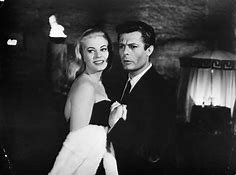“La dolce vita” (Italian for “the sweet life”) isn’t just a phrase; it’s a feeling, an aesthetic, and a way of living. This concept found its most iconic embodiment in Federico Fellini’s 1960 masterpiece, “La Dolce Vita.” More than just a film, it became a cultural touchstone, a window into a bygone era of Roman indulgence and existential ennui.
This article delves into the world of “La Dolce Vita,” exploring its plot, its enduring legacy, and the questions that linger for viewers decades after its release.
A Cinematic Journey Through Roman Nights
“La Dolce Vita” follows Marcello Rubini (played by the legendary Marcello Mastroianni), a jaded tabloid journalist navigating the decadent world of 1960s Rome. His days are filled with celebrity interviews, extravagant parties, and fleeting encounters with beautiful women. However, beneath the glamorous surface lies a sense of emptiness and disillusionment.
Marcello drifts from one social event to another, chronicling the lives of the rich and famous, yet yearning for something more meaningful. He encounters a cast of unforgettable characters, including:
Sylvia (Anita Ekberg): A Scandinavian actress embodying Hollywood glamour, captivating Marcello with her uninhibited spirit.
Emma (Emmaree Reed): A troubled intellectual struggling to reconcile her faith with the city’s hedonism.
Steiner (Alain Delon): A mysterious playboy who embodies a darker side of indulgence.
Through these interactions, Fellini paints a complex picture of postwar Italian society. The film explores themes of celebrity culture, moral ambiguity, and the search for purpose in a world increasingly focused on pleasure.
A Legacy of Cinematic Brilliance: Impact and Recognition
“La Dolce Vita” wasn’t just a successful film; it was a cultural phenomenon. Here’s how it left its mark on cinema:
Cinematic Techniques: Fellini’s innovative camerawork and dreamlike sequences broke new ground in filmmaking. The iconic Trevi Fountain scene with Anita Ekberg remains a testament to the film’s visual power.
Paparazzi Culture: The film introduced the term “paparazzi” to the world, highlighting the intrusive nature of celebrity journalism that continues to be a relevant topic today.
Existential Exploration: It sparked discussions about existentialism, prompting viewers to question the meaning of life and the pursuit of happiness in a seemingly meaningless world.
Fashion and Style: The film’s portrayal of Roman fashion became a trendsetter, influencing styles for years to come.
La Dolce Vita: Enduring Allure and Timeless Themes
“La Dolce Vita” is more than just a film; it’s a cultural touchstone. It offers a glimpse into a specific time and place, yet the themes it explores resonate universally. The film continues to captivate audiences with its stunning visuals, complex characters, and timeless questions about life, love, and the pursuit of happiness. Whether you’re a cinephile or simply curious about a bygone era, It is a cinematic journey worth taking.
FAQs:
What does la dolce vita mean?
It embodies a way of life that emphasizes enjoying the present moment, appreciating beauty and connection, and prioritizing leisure time. It’s about slowing down, taking pleasure in everyday experiences, and finding joy in good company, delicious food, and cultural richness.
Where did the concept of la dolce vita originate?
The term gained widespread popularity in the 1950s and 1960s, particularly after the release of Federico Fellini’s 1960 film “La Dolce Vita.” The film portrays the indulgent lifestyle of a journalist in Rome, surrounded by extravagance and fleeting pleasures. While the film explores the emptiness that can come with such a lifestyle, it also sparked a global fascination with the idealized version of it.
How can I incorporate la dolce vita into my life?
It isn’t about luxury or excess; it’s about a mindful approach to everyday living. Here are some ways to embrace it:
Savor your meals: Take time to enjoy every bite, appreciate the taste and quality of food, and share meals with loved ones.
Prioritize leisure: Don’t be afraid to disconnect and pursue activities you find truly relaxing and enjoyable.
Connect with your community: Spend time with family and friends, participate in local events, and appreciate the beauty of your surroundings.
Embrace slow living: Resist the urge to rush through life. Savor your morning coffee, take walks in nature, and appreciate the small details.
Cultivate a sense of beauty: Surround yourself with art, music, and things that bring you joy. Take time to appreciate the aesthetics of daily life.
What are some common misconceptions about it?
All about idleness: While la dolce vita emphasizes leisure, it doesn’t mean being unproductive. It’s about finding a balance between work and enjoyment.
Only for the wealthy: La dolce vita is accessible to everyone. It’s about appreciating simple pleasures and finding joy in the everyday.
A superficial concept: La dolce vita encourages a deeper connection with life’s simple joys and fosters a sense of well-being.
Where can I find videos about la dolce vita on YouTube?
Travel vlogs: Search for travel vlogs filmed in Italy. These videos often capture the essence of la dolce vita by showcasing Italian culture, cuisine, and beautiful landscapes.
Documentaries: Explore documentaries about Italian life. These can offer a glimpse into the values and traditions that underpin it.
Cooking videos: Learn to cook traditional Italian dishes. Food plays a central role in it, and these videos can help you recreate the flavors and ambiance of an Italian meal.
Italian music videos: Immerse yourself in Italian music. The music often evokes a sense of passion, joy, and connection, reflecting the spirit of la dolce vita.
Is it still relevant today?
In our fast-paced world, it offers a valuable reminder to slow down and appreciate the simple joys in life. It encourages us to find balance, prioritize well-being, and cultivate a sense of connection with ourselves and the world around us. Whether you’re looking to add a touch of Italian flair to your life or simply seeking a more mindful approach to living, it offers a timeless philosophy worth exploring.
To read more, click here.

Leave a Reply